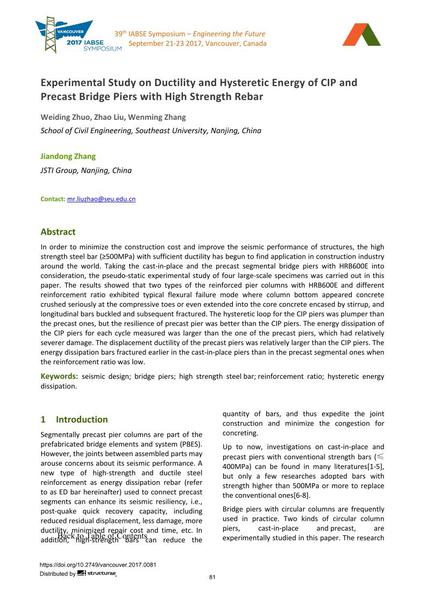Experimental Study on Ductility and Hysteretic Energy of CIP and Precast Bridge Piers with High Strength Rebar

|
|
|||||||||||
Bibliografische Angaben
| Autor(en): |
Weiding Zhuo
(School of Civil Engineering, Southeast University, Nanjing, China)
Zhao Liu (School of Civil Engineering, Southeast University, Nanjing, China) Wenming Zhang (School of Civil Engineering, Southeast University, Nanjing, China) Jiandong Zhang (School of Civil Engineering, Southeast University, Nanjing, China) |
||||
|---|---|---|---|---|---|
| Medium: | Tagungsbeitrag | ||||
| Sprache(n): | Englisch | ||||
| Tagung: | IABSE Symposium: Engineering the Future, Vancouver, Canada, 21-23 September 2017 | ||||
| Veröffentlicht in: | IABSE Symposium Vancouver 2017 | ||||
|
|||||
| Seite(n): | 81-87 | ||||
| Anzahl der Seiten (im PDF): | 7 | ||||
| Jahr: | 2017 | ||||
| DOI: | 10.2749/vancouver.2017.0081 | ||||
| Abstrakt: |
In order to minimize the construction cost and improve the seismic performance of structures, the high strength steel bar (≥500MPa) with sufficient ductility has begun to find application in construction industry around the world. Taking the cast-in-place and the precast segmental bridge piers with HRB600E into consideration, the pseudo-static experimental study of four large-scale specimens was carried out in this paper. The results showed that two types of the reinforced pier columns with HRB600E and different reinforcement ratio exhibited typical flexural failure mode where column bottom appeared concrete crushed seriously at the compressive toes or even extended into the core concrete encased by stirrup, and longitudinal bars buckled and subsequent fractured. The hysteretic loop for the CIP piers was plumper than the precast ones, but the resilience of precast pier was better than the CIP piers. The energy dissipation of the CIP piers for each cycle measured was larger than the one of the precast piers, which had relatively severer damage. The displacement ductility of the precast piers was relatively larger than the CIP piers. The energy dissipation bars fractured earlier in the cast-in-place piers than in the precast segmental ones when the reinforcement ratio was low. |
||||
| Stichwörter: |
Erdbebenbemessung Brückenpfeiler
|
||||
